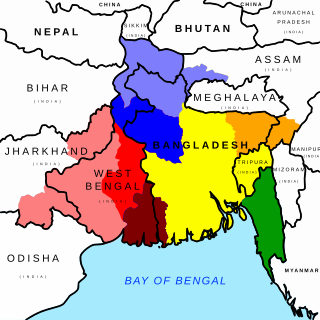Chittagonian (চাটগাঁইয়া saṭgãia or চিটাইঙ্গা siṭaiṅga)[1][2] or Chittagonian Bengali[8][9] is an Indo-Aryan language spoken in parts of the Chittagong Division in Bangladesh.[5] Chittagonian and Standard Bengali are not inherently mutually intelligible, although it is considered by some as a nonstandard Bengali dialect.[5] Chittagonian is also considered to be a separate language by some linguists.[10] Though its speakers identify with Bengali culture and the Bengali language.[3] It is mutually intelligible with Rohingya and to a lesser extent with Noakhailla. It is estimated (2006) that Chittagonian has 13 million speakers, principally in Bangladesh.[5]
| Chittagonian | |
|---|---|
| Chittagonian Bengali | |
| চাটগাঁইয়া[1] চিটাইঙ্গা[2] | |
 | |
| Pronunciation | [saŋʈgaiyaŋ] [siʈaiŋga] |
| Native to | Bangladesh |
| Region | Chittagong region |
| Ethnicity | Bengali[3][4] |
Native speakers | 13 million (2006)[5] to 16 million (2007)[6] |
Indo-European
| |
| Language codes | |
| ISO 639-3 | ctg |
ctg | |
| Glottolog | chit1275 |
| Linguasphere | 73-DEE-aa |
 Map Chittagonian Language speaking area | |
Classification
Chittagonian is a member of the Bengali-Assamese sub-branch of the Eastern group of Indo-Aryan languages, a branch of the wider Indo-European language family. It is derived through an Eastern Middle Indo-Aryan from Old Indo-Aryan, and ultimately from Proto-Indo-European.[5] Grierson (1903) grouped the dialects of Chittagong under Southeastern Bengali, alongside the dialects of Noakhali and Akyab. Chatterji (1926) places Chittagonian in the eastern Vangiya group of Magadhi Prakrit and notes that all Bengali dialects were independent of each other and did not emanate from the literary Bengali called "sadhu bhasha".[11] Among the different dialect groups of these eastern dialects, Chittagonian has phonetic and morphological properties that are not present in standard Bengali and other western dialects of Bengali.[12]
Phonology
Consonants
| Labial | Dental/ Alveolar |
Retroflex | Palatal | Velar | ||
|---|---|---|---|---|---|---|
| Stop | voiceless | p | t̪ | ʈ | k | |
| voiced | b | d̪ | ɖ | ɡ | ||
| Fricative | voiceless | f~ɸ | s | ʃ | x | |
| voiced | z | ɣ | ||||
| Nasal | m | n | ŋ | |||
| Trill/Tap | ɾ~r | |||||
| Approximant | lateral | l | ||||
| central | (w) | j | ||||
- Approximants [w j] are only heard as allophones of vowels /i u/.[13]
- /ʃ/ can have an allophone of [ç].
- /f/ can have a bilabial allophone of [ɸ] .[14]
Vowels
| Front | Central | Back | |
|---|---|---|---|
| High | i | u | |
| High-mid | e | o | |
| Low-mid | (ɛ) | ɔ | |
| Low | æ | a |
- Nasalization occurs for seven vowels /ĩ ẽ æ̃ ã ɔ̃ õ ũ/.
- [ɛ] is heard as an allophone of /æ/.[15]
Writing system
The Bengali script (Bangla Lipi) and Latin script are used to write this language.
See also
Bibliography
- Chatterji, Suniti Kumar (1926). The Origin and Development of the Bengali Language. Calcutta University Press.
- Grierson, G A, ed. (1903). Linguistic Survey of India: Indo-Aryan Family Eastern Group. Vol. V. Archived from the original on 27 June 2020. Retrieved 27 June 2020.
References
- ^ a b Sirajul Islam; Miah, Sajahan; Khanam, Mahfuza; Ahmed, Sabbir, eds. (2012). "Chittagong City". Banglapedia: the National Encyclopedia of Bangladesh (Online ed.). Dhaka, Bangladesh: Banglapedia Trust, Asiatic Society of Bangladesh. ISBN 984-32-0576-6. OCLC 52727562. OL 30677644M. Retrieved 24 December 2024.
- ^ a b চট্টগ্রামের আঞ্চলিক স্বকীয়তা. Prothom Alo (in Bengali). 20 April 2021. Archived from the original on 31 July 2022. Retrieved 16 August 2022.
- ^ a b Masica, Colin (1991). The Indo-Aryan Languages. Cambridge: Cambridge University Press. p. 25.
- ^ Gordon Jr., Raymond G. (2005), Ethnologue: Languages of the World (15th edition), Dallas, Texas: SIL International, ISBN 978-1-55671-159-6, archived from the original on 24 February 2007
- ^ a b c d e Chittagonian at Ethnologue (25th ed., 2022)
- ^ Nationalencyklopedin "Världens 100 största språk 2007" The World's 100 Largest Languages in 2007
- ^ a b "Chittagonian language and alphabet". Archived from the original on 1 August 2022. Retrieved 1 August 2022.
- ^ "Bengali (Chittagong) at wals".
- ^ "Olac resources in and about Chittagonian".
- ^ Masica, Colin (1991). The Indo-Aryan Languages. Cambridge: Cambridge University Press. p. 16. "The dialect of Chittagong, in southeast Bangladesh, is different enough to be considered a separate language."
- ^ "Dialects are independent of literary speech: as such East Bengali dialects, North Bengali dialects (with which Assamese is to be associated) and West Bengali dialects are not only independent of one another, but also they are not, as it is popularly believed in Bengal, derived from literary Bengali, the "sadhu-bhasha", which is a composite speech on an early West Bengali basis."(Chatterji 1926:108)
- ^ Chatterji (1926), p. 138.
- ^ Norihiko, Učida (1970). Der Bengali-dialekt von Chittagong. p. 8.
- ^ Hai, Muhammad A. (1965). A study of Chittagong dialect. In Anwar S. Dil (ed.), Studies in Pakistani Linguistics. pp. 17–38.
{{cite book}}: CS1 maint: location missing publisher (link) - ^ Moniruzzaman, M. (2007). Dialect of Chittagong. In Morshed, A. K. M.; Language and Literature: Dhaka: Asiatic Society of Bangladesh.
- ^ "Gboard for Android Adds Support for Over 20 New Languages". NDTV Gadgets 360. 7 March 2018. Archived from the original on 25 May 2021. Retrieved 25 May 2021.